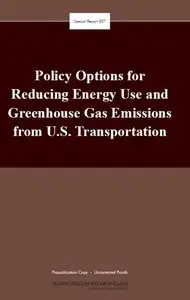Policy Options for Reducing Energy Use and Greenhouse Gas Emissions from U.S. Transportation
Transportation Research Board Special Report 307
TRB NAS Press | 2011 | ISBN: 9780309167420 | 162 pages | PDF | 1 MB
Transportation Research Board Special Report 307
TRB NAS Press | 2011 | ISBN: 9780309167420 | 162 pages | PDF | 1 MB
This Report examines the potential for policies to yield major changes in transportation energy use and emissions trends by policy measures targeting cars and light trucks, medium and heavy trucks, and commercial airliners. These three modes are by far the largest users of energy by U.S. transportation because they account for the vast majority of passenger trips and freight.
Saving energy in transportation can have important implications for the cost of securing the world’s oil supplies, since transportation accounts for most of the petroleum consumed in the United States. It can also help with controlling the buildup of greenhouse gases (GHGs), which will require major reductions in carbon dioxide (CO2) emissions from economic sectors that are heavy users of carbon-rich fossil fuels. Scientific analyses and models indicate a need to stabilize atmospheric concentrations of CO2 and other GHGs by the middle of this century to reduce the risks of climate change. A response by the transportation sector to this energy and emissions challenge will be important because it produces between one-quarter and one-third of all of the CO2 emitted from the country’s energy consumption.
Contents
Summary
1 Study Purpose and Background
Why Examine Policies for a Single Sector, Transportation?
Informing Transportation Policy Choices
Transportation’s Current Dependence on Fossil Fuels
Outlook for Transportation Energy Use
Transportation Energy Use and GHG Buildup
Report Organization
2 U.S. Transportation Today
Scale, Scope, and Patterns of Personal and Goods Transportation
Energy Performance of Major Transport Modes
Considerations Affecting the Adoption of Fuel-Saving and GHG-Reducing Technologies
Summary Assessment
3 Transportation Policy Landscape
Overview of Decision Makers and Actors
Current Policies to Reduce Energy Use and Emissions
New and Proposed Policies
Summary Assessment
4 Factors Driving Modal Energy Use and Emissions
Factors Influencing Trends in Light-Duty Vehicles
Heavy-Duty Trucks
Air Passenger Transportation
Other Modes
Summary Assessment
5 Policy Options to Reduce Transportation’s Energy Use and Greenhouse Gas Emissions
Transportation Policies in the National Context
Transportation-Specific Policy Options
Transportation Fuel Taxes
Vehicle Efficiency Standards
Feebates as Financial Incentives
Low-Carbon Fuel Standards
Measures to Curb Private-Vehicle Travel
Measures Targeted to Freight and Passenger Service
Summary Assessment
6 Informing the Choices Ahead
Aligning Strategic Interests and Policies
Research to Inform Strategic Policy Making
Concluding Observations
Appendix: Scientific Concern over Greenhouse Gas Buildup
Study Committee Biographical Information
with TOC BookMarkLinks



